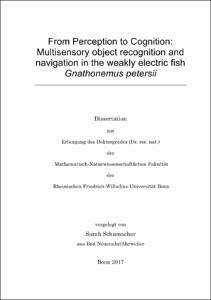From Perception to Cognition: Multisensory object recognition and navigation in the weakly electric fish Gnathonemus petersii

From Perception to Cognition: Multisensory object recognition and navigation in the weakly electric fish Gnathonemus petersii

| dc.contributor.advisor | von der Emde, Gerhard | |
| dc.contributor.author | Schumacher, Sarah | |
| dc.date.accessioned | 2020-04-24T23:07:06Z | |
| dc.date.available | 2020-04-24T23:07:06Z | |
| dc.date.issued | 15.02.2018 | |
| dc.identifier.uri | https://hdl.handle.net/20.500.11811/7493 | |
| dc.description.abstract | Within a multisensory system, individual senses can interact in several beneficial ways increasing the reliability and flexibility of the multisensory percept. Such a multisensory system is found in the African weakly electric fish Gnathonemus petersii , which uses active electrolocation and a specialised visual system for the perception of its environment. Additionally, these fish possess a mechanosensory lateral line system, which, however, has been scarcely investigated. In this thesis I used two behavioural paradigms, object recognition and navigation, as well as anatomical methods to investigate how the sensory systems of G. petersii operate together and how multisensory information is processed. The results during object recognition show that G. petersii is capable of spontaneous cross-modal object recognition, a highly cognitive ability previously known only in a few mammalian species, during which object related information can be transferred between senses and used for object recognition in a flexible manner. Furthermore, I found that these fish process multisensory information similarly to mammals, by using dynamic weighting of sensory inputs. The anatomical studies of the mechanosensory lateral line system additionally show a reduction of the peripheral lateral line system, explaining why the lateral line system was not involved in object recognition during my experiments. In the second part of my thesis the results of the navigational experiments show that G. petersii uses an egocentric strategy aided by visual landmarks for navigation in a familiar environment and is able to use cross-modal landmark recognition to fulfil the task. In conclusion, the results of my thesis show that the multisensory system of G. petersii optimally exploits the advantages of possessing multiple senses, which provide similar information on different spatial scales and provide new insights into the mechanisms underlying multisensory processing in non-mammalian vertebrates. | |
| dc.language.iso | eng | |
| dc.rights | In Copyright | |
| dc.rights.uri | http://rightsstatements.org/vocab/InC/1.0/ | |
| dc.subject | multisensorische Wahrnehmung | |
| dc.subject | visuelles System | |
| dc.subject | elektrischer Sinn | |
| dc.subject | Seitenliniensystem | |
| dc.subject | Objekterkennung | |
| dc.subject | Navigation | |
| dc.subject.ddc | 590 Tiere (Zoologie) | |
| dc.title | From Perception to Cognition: Multisensory object recognition and navigation in the weakly electric fish Gnathonemus petersii | |
| dc.type | Dissertation oder Habilitation | |
| dc.publisher.name | Universitäts- und Landesbibliothek Bonn | |
| dc.publisher.location | Bonn | |
| dc.rights.accessRights | openAccess | |
| dc.identifier.urn | https://nbn-resolving.org/urn:nbn:de:hbz:5n-49643 | |
| ulbbn.pubtype | Erstveröffentlichung | |
| ulbbnediss.affiliation.name | Rheinische Friedrich-Wilhelms-Universität Bonn | |
| ulbbnediss.affiliation.location | Bonn | |
| ulbbnediss.thesis.level | Dissertation | |
| ulbbnediss.dissID | 4964 | |
| ulbbnediss.date.accepted | 13.12.2017 | |
| ulbbnediss.institute | Mathematisch-Naturwissenschaftliche Fakultät : Fachgruppe Biologie / Institut für Zoologie (IZ) | |
| ulbbnediss.fakultaet | Mathematisch-Naturwissenschaftliche Fakultät | |
| dc.contributor.coReferee | Burt de Perera, Theresa |
Files in this item
This item appears in the following Collection(s)
-
E-Dissertationen (4116)




